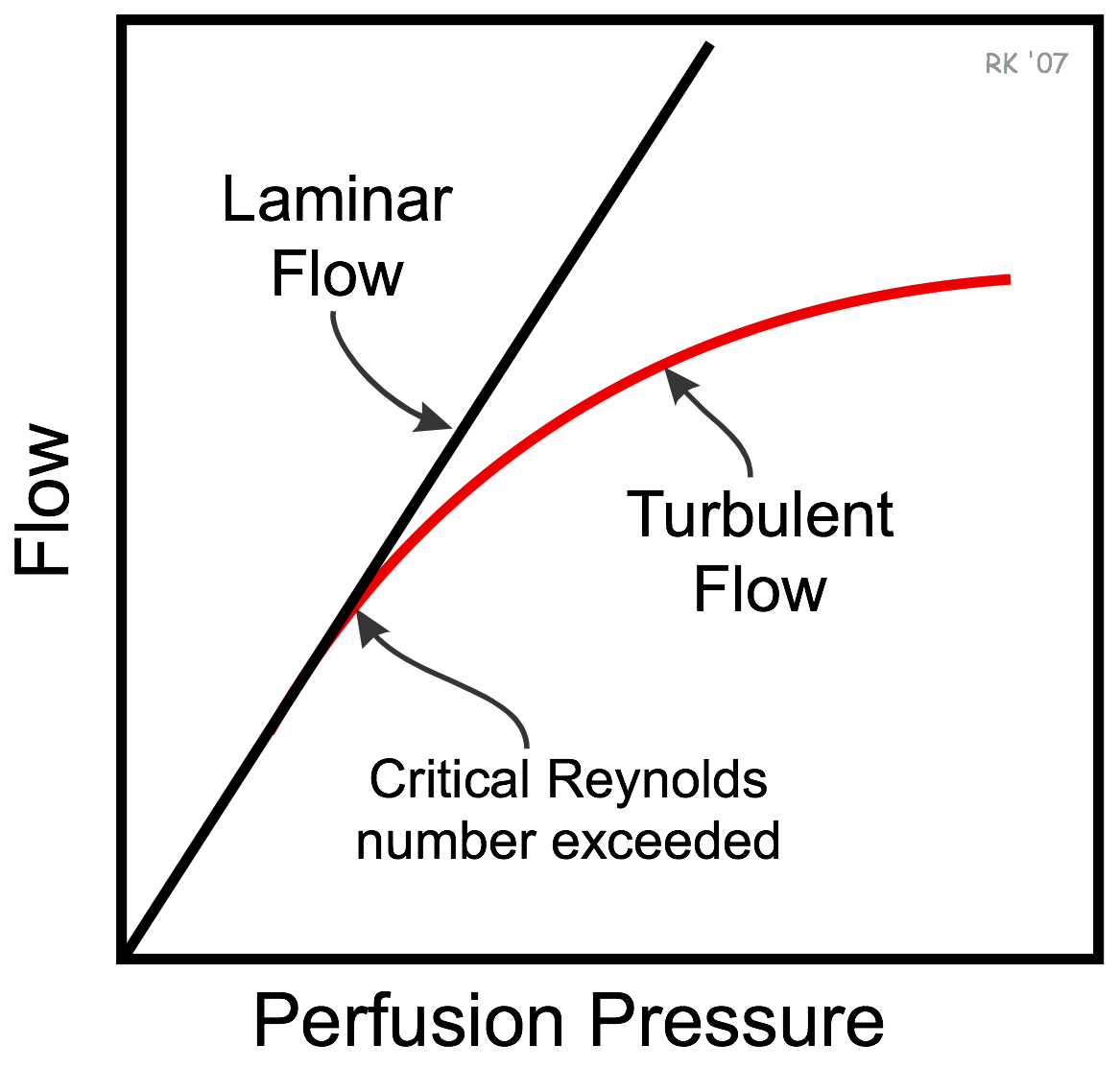Turbulent Flow
 In the body, blood flow is laminar in most blood vessels. However, under conditions of high flow, particularly in the ascending aorta, laminar flow can be disrupted and turbulent. When this occurs, blood does not flow linearly and smoothly in adjacent layers, but instead, the flow can be described as being chaotic. Turbulent flow also occurs in large arteries at branch points, in diseased and narrowed (stenotic or partially obstructed) arteries (see figure), and across stenotic heart valves.
In the body, blood flow is laminar in most blood vessels. However, under conditions of high flow, particularly in the ascending aorta, laminar flow can be disrupted and turbulent. When this occurs, blood does not flow linearly and smoothly in adjacent layers, but instead, the flow can be described as being chaotic. Turbulent flow also occurs in large arteries at branch points, in diseased and narrowed (stenotic or partially obstructed) arteries (see figure), and across stenotic heart valves.
 Turbulence increases the energy required to drive blood flow because turbulence increases the loss of energy as friction, which generates heat and is dissipated. When plotting a pressure-flow relationship (see figure), turbulence increases the perfusion pressure required to drive a particular flow. Alternatively, at a specific perfusion pressure, turbulence leads to a decrease in flow.
Turbulence increases the energy required to drive blood flow because turbulence increases the loss of energy as friction, which generates heat and is dissipated. When plotting a pressure-flow relationship (see figure), turbulence increases the perfusion pressure required to drive a particular flow. Alternatively, at a specific perfusion pressure, turbulence leads to a decrease in flow.
Turbulence does not occur until the velocity of flow becomes high enough that the flow lamina separate. Therefore, as blood flow velocity increases in a blood vessel or across a heart valve, there is not a gradual increase in turbulence. Instead, turbulence occurs when a critical Reynolds number (Re) is exceeded, and the turbulence then increases further at higher velocities. The Reynolds number is a way to predict, under ideal conditions, when turbulence will occur. The equation for Reynolds number is:
 In this equation, V = mean velocity, D = vessel diameter, ρ = blood density, and η = blood viscosity).
In this equation, V = mean velocity, D = vessel diameter, ρ = blood density, and η = blood viscosity).
As seen in this equation, Re increases as velocity increases and decreases as viscosity increases. Therefore, high velocities and low blood viscosity (as occurs with anemia because of reduced hematocrit) are more likely to cause turbulence. An increase in diameter without a change in velocity also increases Re and the likelihood of turbulence occurring; however, the velocity in vessels ordinarily decreases disproportionately as the diameter increases. This is because flow (F) equals the product of mean velocity (V) times cross-sectional area (A), and area is proportionate to radius squared; therefore, the velocity of constant flow is inversely related to radius (or diameter) squared. For example, if the radius (or diameter) is doubled, the velocity decreases to one-fourth its normal value, and Re decreases by one-half.
Under ideal conditions (e.g., long, straight, smooth blood vessels), the critical Re is relatively high. However, in branching vessels, or in vessels with atherosclerotic plaques protruding into the lumen, the critical Re is much lower, so turbulence can occur even at normal flow velocities.
Turbulence generates sound waves (e.g., ejection murmurs, carotid bruits) that can be heard with a stethoscope. Because higher velocities enhance turbulence, murmurs intensify as flow increases. Elevated cardiac outputs, even across anatomically normal aortic valves, can cause physiological murmurs because of turbulence. This sometimes occurs in pregnant women who have elevated cardiac output (elevated ejection velocities) and reduced blood viscosity because of anemia. Both factors increase the Reynolds number, which increases the likelihood of turbulence.
Revised 11/05/2023

 Cardiovascular Physiology Concepts, 3rd edition textbook, Published by Wolters Kluwer (2021)
Cardiovascular Physiology Concepts, 3rd edition textbook, Published by Wolters Kluwer (2021) Normal and Abnormal Blood Pressure, published by Richard E. Klabunde (2013)
Normal and Abnormal Blood Pressure, published by Richard E. Klabunde (2013)